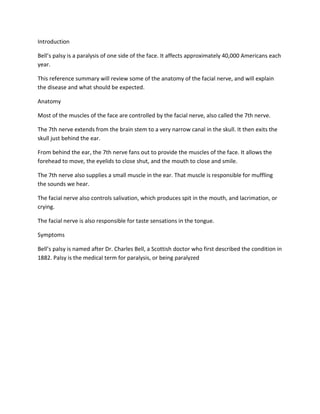
Bell's palsy nursing notes
- 1. Introduction Bell’s palsy is a paralysis of one side of the face. It affects approximately 40,000 Americans each year. This reference summary will review some of the anatomy of the facial nerve, and will explain the disease and what should be expected. Anatomy Most of the muscles of the face are controlled by the facial nerve, also called the 7th nerve. The 7th nerve extends from the brain stem to a very narrow canal in the skull. It then exits the skull just behind the ear. From behind the ear, the 7th nerve fans out to provide the muscles of the face. It allows the forehead to move, the eyelids to close shut, and the mouth to close and smile. The 7th nerve also supplies a small muscle in the ear. That muscle is responsible for muffling the sounds we hear. The facial nerve also controls salivation, which produces spit in the mouth, and lacrimation, or crying. The facial nerve is also responsible for taste sensations in the tongue. Symptoms Bell’s palsy is named after Dr. Charles Bell, a Scottish doctor who first described the condition in 1882. Palsy is the medical term for paralysis, or being paralyzed
- 2. In patients with Bell’s palsy, the facial nerve suddenly quits working. The weakness reaches its worse point within 48 hours. The most impressive finding of this disease is the paralysis of the facial muscles. With the facial muscles paralyzed, the eye is not able to close and the mouth droops. The malformation of the face with Bell’s palsy is usually very unusual and disfiguring. The good news is that Bell’s palsy usually improves on its own in a matter of weeks to months. The 7th nerve usually heals itself completely. Along with paralysis, Bell’s palsy patients may experience sounds being louder than usual and some pain in the ear area. Patients with Bell’s palsy may experience loss of taste sensations on the affected side of the mouth. Lack of taste is sometimes not even noticed since the other side of the tongue’s taste sensation still works. Causes The cause of Bell’s palsy is thought to be a viral infection of the 7th nerve. Inflammation due to the infection causes the nerve to swell. The nerve may choke itself in the thin bony tunnel on its way to the face.
- 3. Herpes simplex, the common cold sore virus, is thought to cause the viral infection that leads to Bell’s palsy. It also disproportionately affects pregnant women, diabetics, patients suffering from the flu or a cold. Other diseases that can cause symptoms similar to Bell’s palsy, include • tumors • strokes • infections Diagnosis In order to diagnose Bell’s palsy, the doctor will take a detailed medical history and do a thorough examination. An EMG and NCV test may be done to check for the nerve damage. EMG stands for electromyography and NCV stands for nerve conduction velocity. An EMG and NCV involve placing small needles in the muscles of the face and shocking the nerves with very mild electric current. Though not pleasant, the test is not very painful and is usually well tolerated. MRIs and CAT scans of the brain may be done to make sure that the problem is not caused by a stroke, a tumor, or an infection. If an MRI or CAT scan reveals a stroke, tumor, or infection, it is not likely that the 7th nerve will improve. The doctor can usually detect other signs of these symptoms during the examination. Treatment 75% of patients with Bell’s palsy improve without treatment. However recent studies have shown that treatment with steroids and an antiviral medication (acyclovir) are probably effective in improving facial function. The steroids decrease the swelling. These medications include prednisone, dexamethasone, etc.
- 4. Face massage can keep facial muscles from contracting, keeping them flexible and elastic for when the nerve heals. In extremely rare cases of Bell’s palsy, surgery may be recommended. Patients may also be given an eye patch and eye drops to protect the eye from injury and from drying up. Complications Even though most patients recover, sometimes the recovery is not complete and some weakness may continue. Sometime the 7th nerve does not recover correctly. The fibers that are supposed to go to the salivary glands end up going to the lacrimal glands in the eye. This causes patients to cry rather than salivate when they are eating. This is called “crocodile tears.” During the acute attack of Bell’s palsy patients should protect the involved eye. If the eyelids cannot close all the way together, the eye could be easily injured by dust, sand, rubbing etc. You may be given a patch to help protect the eye mainly at night. Artificial tears can prevent the eye from drying up and getting damaged. If the weakness becomes permanent, an operation to surgically narrow the eye opening may be necessary. Summary Bell’s palsy is a common condition that 3 out of 4 patients fully recover from. It is important to protect the eye during acute attacks to prevent it from permanent damage. NCLEX Reviews. This document is a summary of what appears on screen in NervousNurses.com™. It is for informational purposes and is not intended to be a substitute for the advice of a doctor or healthcare professional or a recommendation for any particular treatment plan. Like any printed material, it may become out of date over time. It is important that you rely on the advice of a doctor or a healthcare professional for your specific condition. Nursing Notes